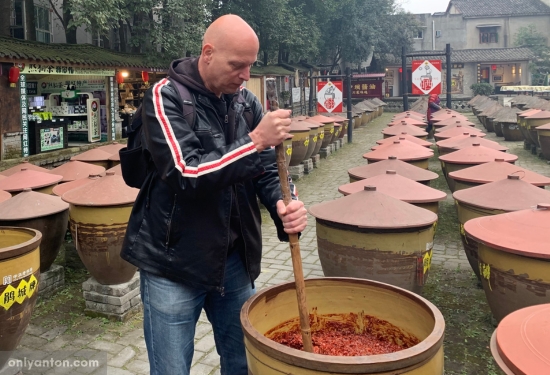
Introduction
Step into Chengdu, the centre of Sichuan cuisine, where the air is thick with the tantalizing aroma of Sichuan peppers and the streets are alive with the sizzle of woks. Chengdu, the capital of Sichuan province, is a haven for food enthusiasts. As a UNESCO City of Gastronomy, Chengdu boasts a culinary heritage that’s as fiery as its famous hotpot.
Join me on a culinary odyssey through Chengdu as I delve into the heart of Sichuan cuisine. In this blog post, I’ll take you through the bustling markets and hidden alleys of Chengdu, exploring the rich flavours and cultural significance of Sichuan cuisine. From the educational Sichuan Cuisine Museum to the vibrant street food scene, get ready for a food trip that will ignite your taste buds and leave you craving more.
Location
Chengdu, the capital of Sichuan Province, is located in southwestern China. Sichuan Province, known for its mountainous terrain and fertile plains, lies in the upper reaches of the Yangtze River and is bordered by several provinces, including Yunnan, Guizhou, and Shaanxi. Chengdu is situated in the heart of the Sichuan Basin, making it a central hub for the region’s economic, cultural, and culinary activities. Renowned for its spicy cuisine, vibrant street food culture, and historic sites, Chengdu is also a gateway to exploring the diverse landscapes and rich traditions of Sichuan Province.
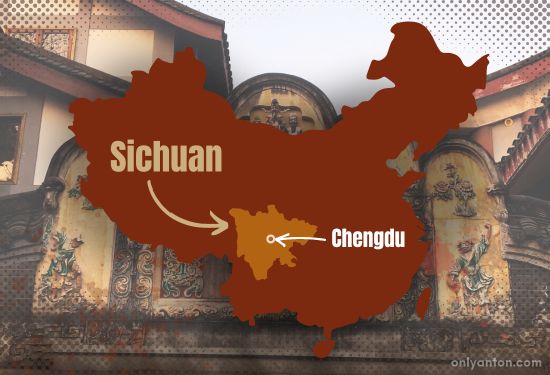
The Heritage of Sichuan Cuisine
Chengdu is renowned for its fiery cuisine. This vibrant city boasts a culinary tradition that dates back thousands of years. Bold flavours, unique ingredients, and a rich cultural heritage characterize the food in this Chinese province.
Sichuan cuisine is known as one of the Eight Great Traditions of Chinese Cuisine. Each of these traditions has its own unique styles, ingredients, and cooking techniques, reflecting China’s diverse foodways. Sichuan cuisine is characterized by its use of garlic, ginger, fermented soybeans, and a variety of seasonings and spices.
However, Sichuan cuisine is not only about flavours but also about the art of balance. Dishes often feature a combination of spicy, sweet, sour, and salty flavours. Each dish reflects the region’s rich culinary history and the importance of food in Sichuan culture.
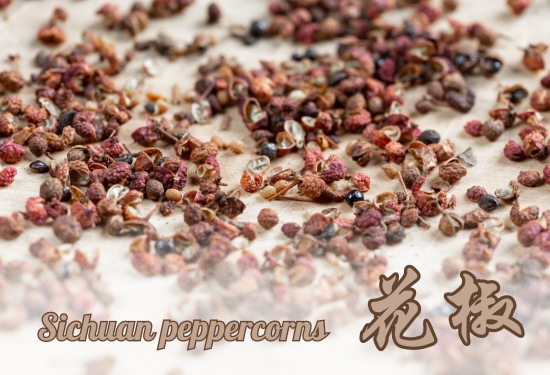
The Sichuan Peppercorn
At the heart of Sichuan’s culinary scene is the famous Sichuan peppercorn. Sichuan peppercorns (hua jiao, 花椒) are not true peppercorns. They are the dried seed husks of the prickly ash tree. They have a distinct citrusy aroma and create a tingling, numbing sensation in the mouth when consumed.
Peppercorn compounds interact with the nerve endings in the mouth. Together with fiery chiles, they create the signature numbing and spicy flavour known as mala (麻辣). This unique flavour can often be addictive. The numbing quality reportedly enables the ingestion of more and spicier chiles.
Sichuan peppercorns are used in various forms, including whole, ground, and as an oil. They are a key ingredient in dishes like Mapo Tofu and Sichuan Hotpot. Apart from their culinary uses, Sichuan peppercorns are valuable for their medicinal properties and can aid digestion and promote overall well-being.
This distinct flavour profile reflects the region’s history, geography, and lifestyle, making Sichuan cuisine a fascinating window into the culture and traditions of this dynamic province.
Sichuan Cuisine Museum
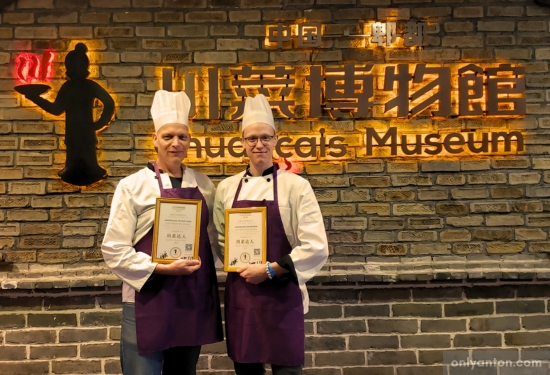
The Museum Experience
Located about an hour’s drive northwest of Chengdu, the Sichuan Cuisine Museum (the Chuancais Museum) offers visitors a unique opportunity to immerse themselves in the world of Sichuan cuisine. Treasures in the Classical Collection Hall greet visitors as they enter the museum.
The collection of over 6,000 antiques and artifacts showcases the history and evolution of Sichuan cooking, with a particular focus on the use of hot chiles. Among the items on display are books, pictures, manuscripts, chopsticks, bowls, and other assorted kitchen utensils. [pic of jars]
Behind the main museum building are rows of large earthen jars containing batches of Sichuan hot chile sauce. The containers exhibit the various stages of development and offer a glimpse into the traditional methods of producing the famed Pixian Chile Bean Paste.
This condiment and cooking ingredient is a specific and highly esteemed variety of Douban Jiang (spicy broad bean paste). The unique ingredients, longer fermentation process, and rich, complex flavour profile serve to distinguish it from other types of Douban Jiang. It is a staple ingredient in Sichuan cuisine and imparts a distinctive spicy and umami taste to dishes.
Another part of the Chuancais Museum is the “edible” museum, which showcases Sichuan food culture. Visitors can wander around the food courtyard and sample typical dishes like Sichuan-style stuffed pancakes, Northern Sichuan-style jelly, tofu pudding, zhong dumplings, Sichuan pickles, golden thread-like noodles, and more.
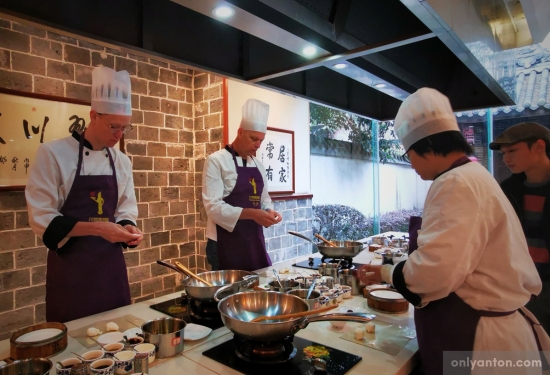
Hands-On Cooking Class
My son and I took part in our own culinary adventure with a hands-on cooking class at the Sichuan Cuisine Museum. The class offers a chance to experience Sichuan cuisine firsthand under the direction of a local chef. Normally, the class accommodates larger groups. However, my son and I were the only participants on this occasion.
We moved to our workstations, where we found the necessary ingredients, including the essential Sichuan peppercorns and fiery red chiles. Under the chef’s guidance, we learned to prepare several iconic Sichuan dishes, including sweet panda dumplings and a spicy beef dish. The highlight was the classic Kung Pao Chicken (gong bao ji ding, 宮保雞丁).

Kung Pao Chicken originated in the Sichuan province and has become a staple of Chinese cuisine worldwide. It features tender chicken pieces stir-fried with peanuts, vegetables, and chile peppers, creating a tantalizing mix of textures and flavours. The dish is named after Ding Baozhen, a Qing dynasty official known for his love of spicy food.
Cultural Significance of Sichuan Cuisine
Sichuan cuisine is not just about the flavours and ingredients; it’s a reflection of the region’s history, lifestyle, and cultural values. The bold and spicy flavours are a testament to the region’s resilience and resourcefulness. Sichuan’s humid climate historically necessitated the use of spices to preserve food and ward off illness. Moreover, the communal nature of Sichuan dining, particularly exemplified by the hotpot, reflects the importance of family and community in Sichuanese culture.
A Sichuan cooking class gives you a glimpse into the secrets of authentic Sichuan cuisine. In addition, it provides insights into the region’s rich history and culture. This hands-on experience offers a unique and tasty perspective on the culinary traditions that have shaped Chengdu into a gastronomic paradise.
Sichuan Street Food
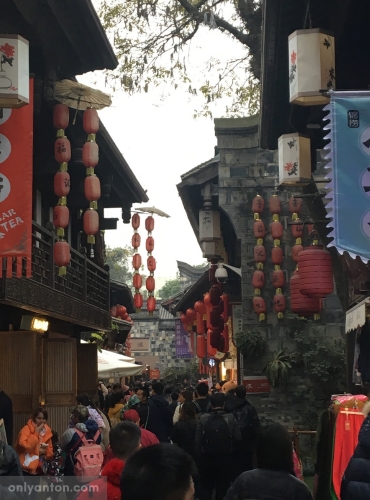
In Chengdu, the lively street food scene is a sensory overload. Every alleyway beckons with tantalizing aromas and buzzing energy. As my son and I navigated through the crowded markets and narrow streets, we were enveloped in a whirlwind of sights, sounds, and smells that epitomized the essence of Sichuan cuisine. Local vendors lined the streets, each with their own unique specialties and stories to tell. [pic of Jinli St]
One of the best places to try Sichuan street food is in the Jinli Ancient Street (Jinli Gujie, 锦里古街) area of Chengdu. Jinli is a popular pedestrian area known for its traditional architecture, vibrant atmosphere, and wide array of local snacks and delicacies. It’s a fantastic place to immerse yourself in Sichuan’s culinary delights and experience the local food culture.
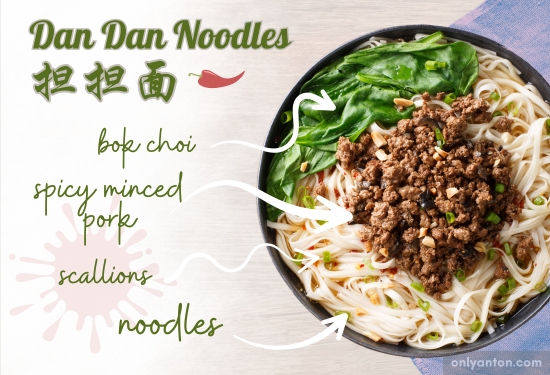
Dan Dan Noodles
One of my most memorable encounters was with a vendor selling Dan Dan Noodles. This is a classic Sichuan dish known for its bold flavours and spicy kick. Dan Dan Noodles (dan dan mian, 担担面) originated from street vendors in Chengdu. Originally, it was a simple noodle dish served with spicy sauce and preserved vegetables. The name “dan dan” refers to the carrying pole (dan zi, 担子) used to transport the noodles and sauce.
Over time, variations have emerged. The Sichuan version typically features noodles topped with a spicy, savoury sauce made with chile oil, Sichuan peppercorns, minced pork, and preserved vegetables. The dish has become a staple of Sichuan cuisine and is popular in China and internationally.
The vendor, a middle-aged woman with a warm smile, deftly tossed the noodles in a fiery chile oil sauce, garnishing them with minced pork and crunchy peanuts. With each bite, I was transported to culinary bliss, the rich flavours dancing on my palate.
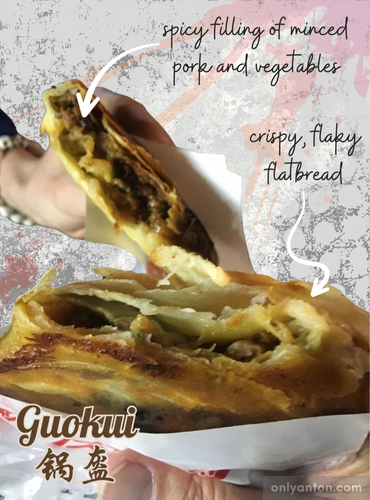
Guokui
Another highlight was the Guokui stall (guo kui, 锅盔). Guokui is a kind of flatbread that originated in Shaanxi cuisine, but there are several variations. A skilled chef deftly rolled out thin layers of dough, stuffed them with a savoury filling of minced pork and spices, and then baked them to crispy perfection in a clay oven. The aroma of the freshly baked Guokui drew in a crowd of hungry onlookers eager to sample this delectable treat.
Sichuan Tofu Custard
Every corner of this street food district offers a new culinary delight. One of my favourites is Sichuan-style Doufu Hua (豆腐花). Also known as Spicy Tofu Pudding or Tofu Custard, it is a popular street food in Sichuan cuisine. It has a soft, silky texture and bold, spicy flavours. The typical ingredients for the savoury version include:
- Soft Tofu (Doufu hua): The tofu used in this dish is extremely soft and smooth, similar to a very delicate custard or pudding.
- Chile Oil: A key component of Sichuan cuisine, chile oil adds heat and vibrant red colour to the dish.
- Sichuan Peppercorns: Ground or whole Sichuan peppercorns provide the signature numbing sensation (mala) characteristic of Sichuan dishes.
- Soy Sauce: Adds umami and a salty depth to the seasoning.
- Vinegar: A splash of black or red vinegar balances the flavours with a touch of acidity.
- Ground Pork: Sometimes, finely minced or ground pork is added to the dish for extra savoriness and texture.
- Scallions and Garlic: Chopped scallions and minced garlic are used as garnishes, adding freshness and aroma.
- Preserved Mustard Greens (zha cai): These are optional but often included for an added salty and slightly sour crunch.
- Sesame Oil: A drizzle of sesame oil can be added for a nutty fragrance.
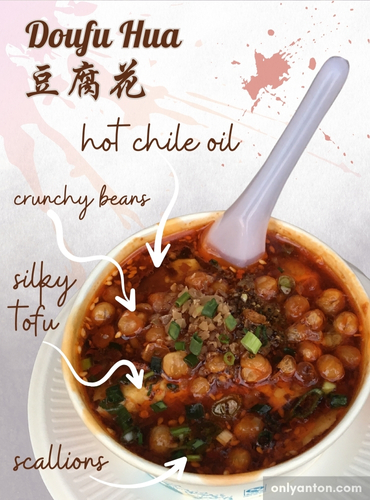
Differences Between Doufu Hua and Mapo Tofu
In many respects, Doufu Hua is similar to the classic Sichuan dish Mapo Tofu or Mapo Doufu (麻婆豆腐). However, there are some key differences between the two:
- Texture of Tofu:
- Doufu Hua uses extremely soft and silky tofu that has a melt-in-your-mouth texture.
- Mapo Tofu uses slightly firmer tofu, usually soft or medium-firm but still tender. The tofu is cut into cubes and retains its shape during cooking.
- Preparation and Presentation:
- Doufu Hua is typically served as a snack or breakfast item. It is often presented in a bowl with a variety of toppings, including a spicy and savoury sauce.
- Mapo Tofu is usually a main course dish. It is a stir-fry that includes tofu cubes cooked in a spicy and aromatic sauce made from Douban Jiang (fermented broad bean and chile paste), chile oil, Sichuan peppercorns, garlic, and ground pork.
- Spiciness and Flavor Profile:
- Doufu Hua’s spiciness can vary depending on the amount of chile oil and Sichuan peppercorns used. The dish is primarily savoury, with a balance of spicy, numbing, and sometimes slightly sour flavours.
- Mapo Tofu is known for its bold and complex flavours, its spicy and numbing mala, and its rich umami taste from the Douban Jiang and meat.
- Additional Ingredients:
- Doufu Hua may include toppings like scallions, minced meat, preserved mustard greens, and sometimes peanuts.
- Mapo Tofu typically includes ground pork (or beef) as an essential ingredient, along with green onions and sometimes peas or other vegetables for added texture and colour.
In summary, the main differences between Sichuan Doufu Hua and Mapo Tofu lie in the texture of the tofu, the preparation and presentation of the dishes, the spiciness and flavour profile, and the additional ingredients used.
Sichuan Peanut Brittle
For those with a sweet tooth, the Huasheng Tang is a delightful treat. Huasheng Tang (花生糖) is a traditional Sichuan snack made from peanuts. The name literally translates to “peanut candy” or “peanut brittle.” It’s a sweet and crunchy treat quite popular in Sichuan and other parts of China.
Huasheng Tang is made by caramelizing sugar and then mixing in roasted peanuts. The mixture is then spread out and cooled, forming a hard, brittle candy. Once cooled, it’s broken into smaller pieces for consumption. The candy has a sweet and nutty flavour, with a satisfying crunch from the peanuts. Often, it’s enjoyed as a snack or a gift during festivals and special occasions.
Roasted Rabbit Head
One of the most surprising dishes we encountered was Roasted Rabbit Head (kao tutou, 烤兔头). While it may sound unusual to some, it’s a delicacy in Sichuan cuisine. Roasted Rabbit Head is a unique delicacy in Sichuan cuisine. It’s known for its flavorful and tender meat, particularly the cheeks, and the crunchy texture of the skull. It’s often seasoned with spices and served as a popular street food snack. We approached it with curiosity and found ourselves enjoying the experience, appreciating the opportunity to try something truly unique.
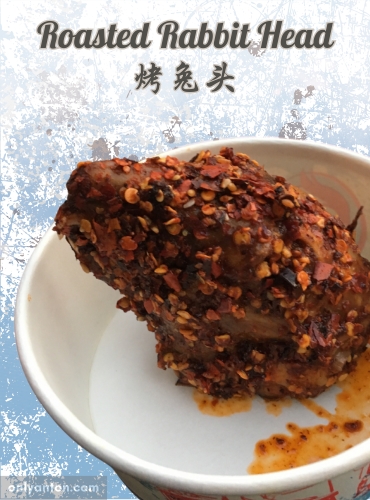
As we wandered through the bustling streets of Chengdu, each bite of street food not only satisfied our hunger but also deepened our appreciation for the rich tapestry of Sichuan cuisine. From the fiery kick of Dan Dan Noodles to the unexpected delight of Roasted Rabbit Head, these culinary encounters revealed the creativity, diversity, and bold flavours that define this region’s food culture.
As we conclude our culinary odyssey, it’s clear that the streets of Chengdu are not just pathways through the city but gateways to understanding the heart and soul of Sichuan cuisine.
Conclusion
As my culinary journey through Chengdu comes to a close, I’m left with a profound appreciation for the bold and complex flavours of Sichuan cuisine. From the educational insights at the Sichuan Cuisine Museum to the sensory overload of street food markets, Chengdu has proven to be a true gastronomic paradise.
Whether it’s the numbing spice of Mapo Tofu or the sweet crunch of Huasheng Tang, each dish tells a story of tradition, innovation, and community. I encourage all food lovers to embark on their own Sichuan culinary adventure, whether in the lively streets of Chengdu or in their own kitchens. Share your experiences and favourite dishes in the comments below, and let’s continue to celebrate the treasure of Sichuan cuisine together.
Further Reading:
Related Posts
To read more about Sichuan, check out these blog posts:
External Resources
To learn more about the activities in Chengdu described above, take a look at some of the following resources:
- The Sichuan Cuisine Museum: Learn more about a visit to the Sichuan Cuisine Museum, or even book your own visit here.
- Wikipedia, “Sichuan Cuisine”: An overview of the characteristics of Sichuan cuisine. Learn more about it here.
- Wikipedia, “Chengdu”: Learn more about the capital of Sichuan province here.
- Bon Appétit, “What Are Sichuan Peppercorns?” (Sept. 29, 2021) by Chala June. An article that describes this essential element of Sichuan cuisine. Read it here.




